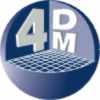Simulation is a broad field encompassing many niche fields including training simulators, photorealistic visualisation, animations, and in the case of 4dm – Process Simulation.
This means building a digital twin of a real world process, a 4d model. The elements in our models can be anything from an ASRS to mine vehicles, conveyors, people, parts on an assembly line, or forklifts driving around a site.
These elements are given the same properties as the real thing, (for example speed, process time, break down frequency etc), and they are given the logics to make them replicate real world behaviour.
Most modellers use combinations of simple building blocks to create simulations, avoiding complex coding at all costs. However we recognised long ago that systems worth simulating are by nature highly complex and totally unique – if it was simple we wouldn’t be using simulation at all!
This means that to create accurate simulations, custom algorithms are almost always needed. To mitigate this we’re continually developing our own library of AI code blocks, that are designed to be flexible and easily edited to suit a particular project without starting from scratch. These AI blocks represent specific model tasks like data import, controlling moving elements (vehicles, asrs systems, robots, cranes, indexing tables), controlling warehouse stock, forklift or AGV task selection, and data ouput. So we’re still tailoring new algorithms for every job, but usually with only half the workload.
Having built and verified a model, we can run scenarios to optimise a process, or test the sensitivity of certain parameters. Using custom reporting we can measure literally anything that’s occurring in the model, and then report on it in a sensible data driven way.
Why 4d Modelling?
Because graphical models provide you with much more than just the hard numbers, they are easier to understand, and therefore easier to verify and communicate ideas through. When you can actually “see” your facility in operation, you can see the vehicles driving around and blocking each other, or see parts running down conveyor belts, or the impact of machine breakdown, it gives you, the client, the opportunity to participate in the verification and optimisation process. When a simulation is in 2d, and you just see icons moving around on a screen, your opportunity to become meaningfully involved is diminished.
Having said this, our models are not photo-realistic, they include just enough detail for the 4d world to be representative of the real system. We believe it makes more sense to spend time on the underlying logic than on the render.
Still, a picture tells a thousand words so it’s commonplace for our models to be included in board presentations.
For more information please get in touch.
